Learn how to make blue “crystal meth” rock candy inspired by Breaking Bad. It’s easier than you think, and the results look AND taste delicious. Perfect for costume and viewing parties!
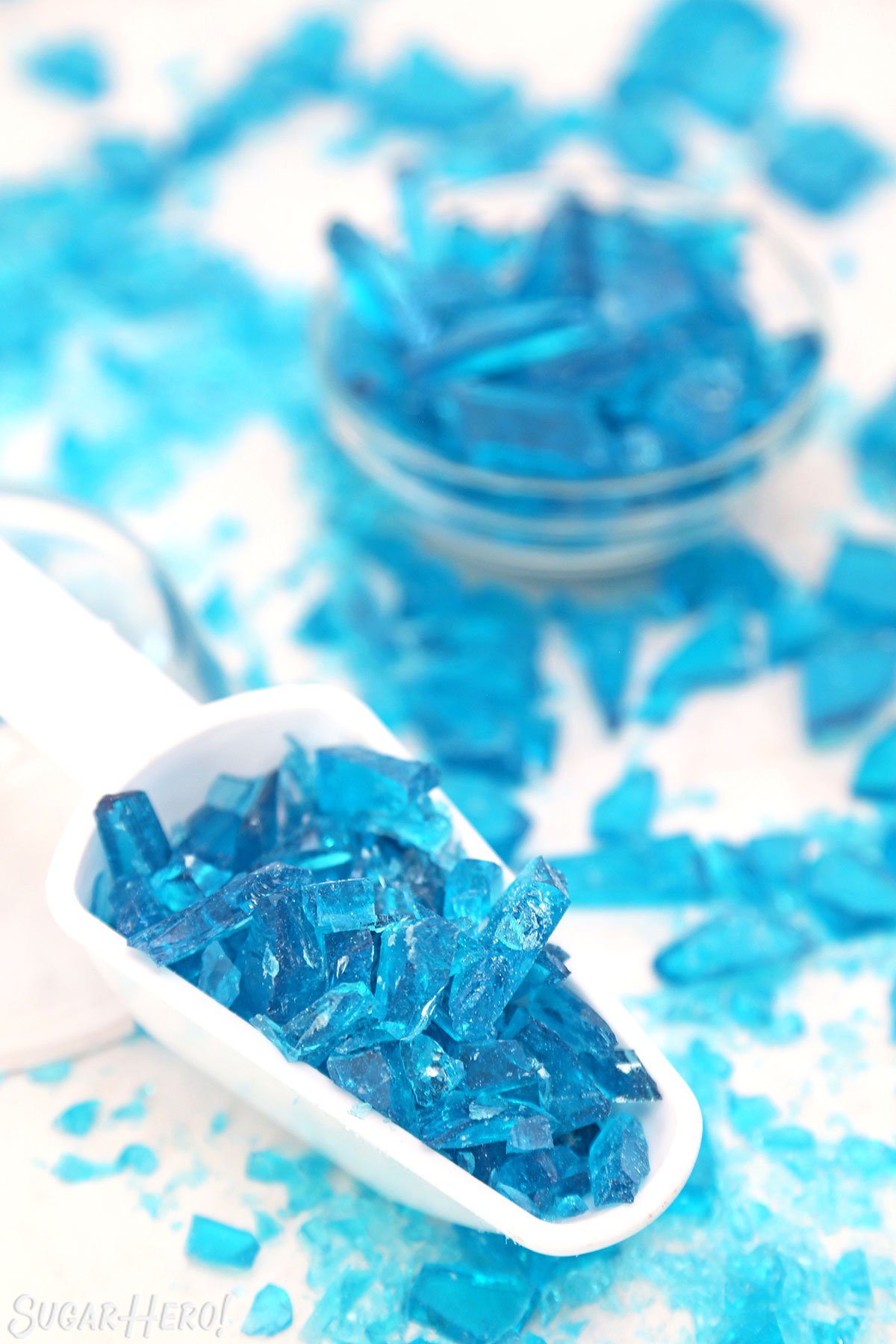
💙 How to make blue rock candy
This rock candy recipe is inspired by the television show Breaking Bad. As any viewer knows, the plot revolves around the blue-tinged crystal meth created by chemistry teacher Walter White and his student-turned-partner Jesse Pinkman. The meth is so pure, so potent, that it changes the entire southwestern drug trade and, eventually, the very lives of its creators.
As a fan of both sugar and television, imagine my delight when I found out that the “meth” used in the show is actually rock candy. Too perfect! So way back in 2012, at the height of Breaking Bad mania, I decided to create my own rock candy recipe, modeled after the Breaking Bad drug, for a viewing party with friends. Since it was first posted a decade ago, hundreds of people have made it for parties and Halloween costumes. Here is just a small sampling of the readers who have made it, loved it, and sent in pictures:
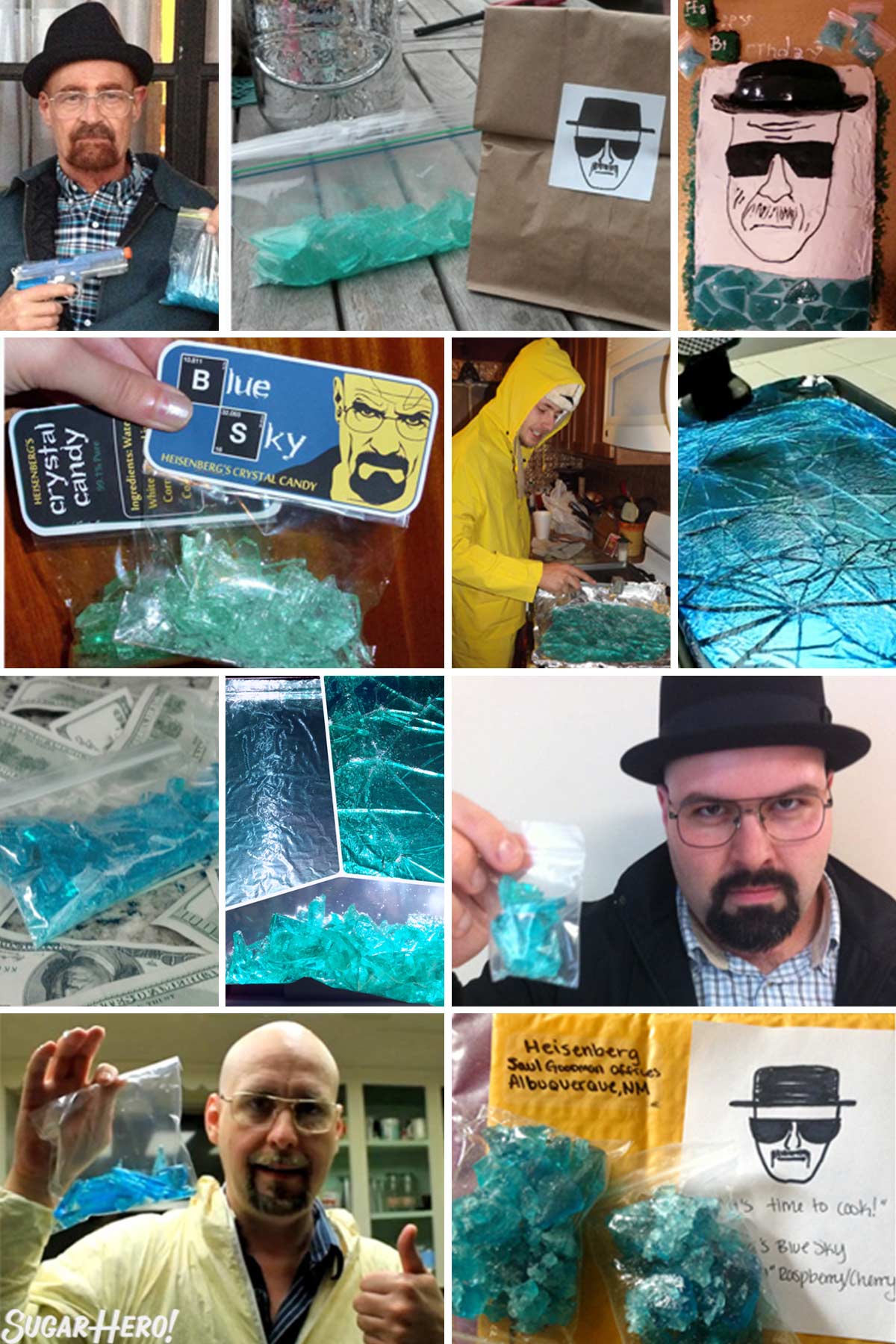
Although Breaking Bad is now off the air, this recipe remains a popular one, so it seemed overdue for an update. I’ve revised the post and recipe to make it more thorough, detailed, and helpful for YOU, my budding little Heisenbergs!
How to rock your candy-making
Rock candy is not difficult to make, and even beginning candy makers can do it successfully on their first try. Here are a few things you can do to ensure success:
- Read the recipe before beginning. This might sound obvious, but you’d be surprised! Once the candy hits a certain temperature things move very fast, and you want to be prepared to act right away, not be stuck reading the next step.
- Use a candy thermometer. More on this below, but it is the #1 tool that will guarantee you success.
- Read the Tips & Troubleshooting sections right before the recipe. Overwhelmingly, when people have trouble with this recipe, it is caused by a few very common mistakes, and knowing what these are in advance will help you avoid them.
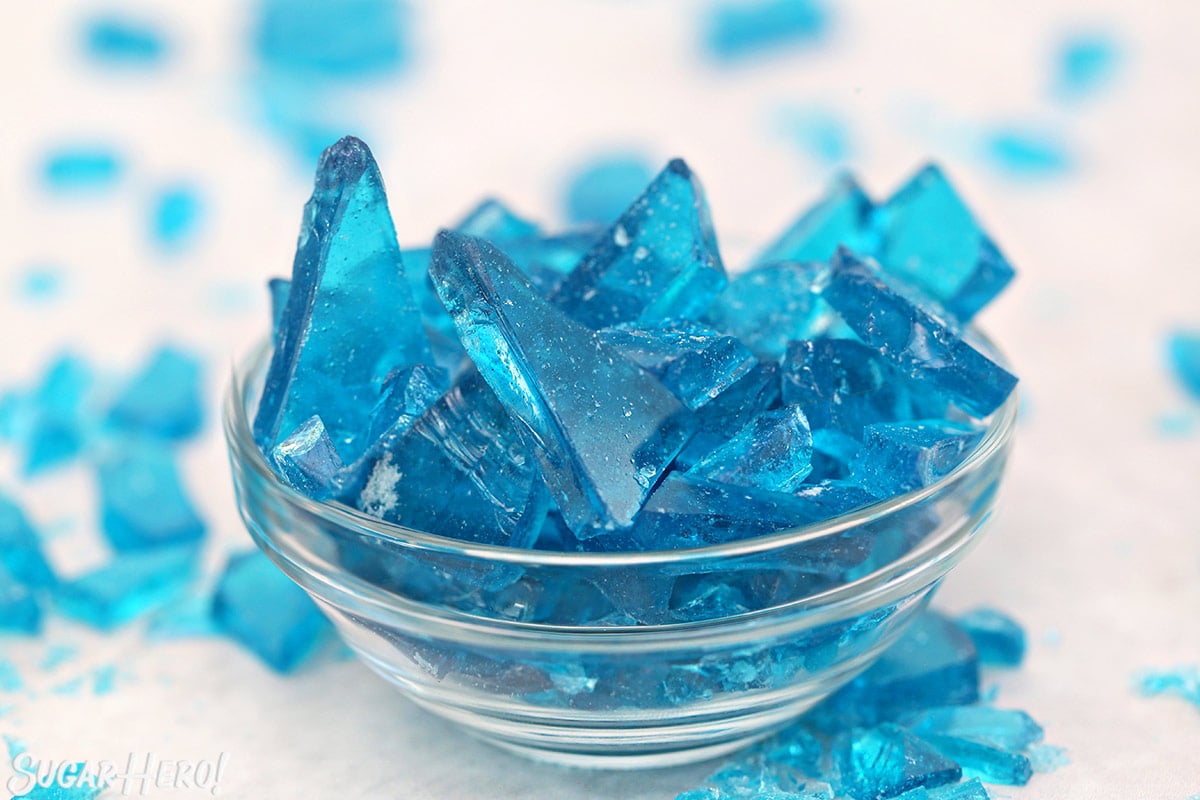
Table of Contents
🧾 What You’ll Need
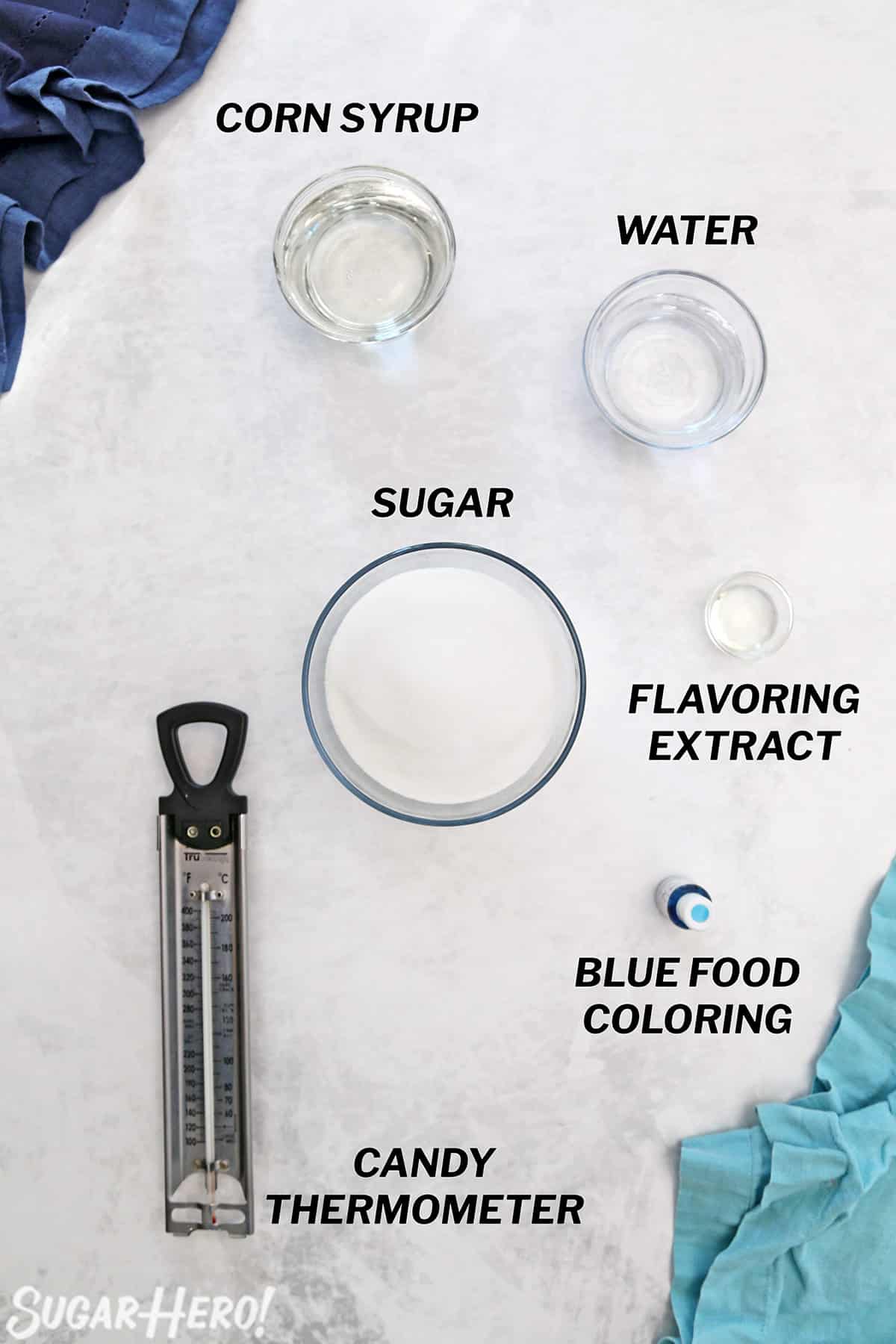
Ingredients & Equipment
Here’s what you need to know as you gather your candy-making supplies. (Links are affiliate links and I earn a small commission from qualifying purchases.)
- Corn syrup: Light corn syrup helps prevent the sugar from crystallizing. If you are not able to easily find it, golden syrup or glucose syrup is a good substitute. Note that golden syrup has a yellow tinge and is likely to turn your finished candy greenish-blue.
- Granulated sugar: Not all sugar is created equal. Some granulated sugar is made from cane sugar, and some comes from beets. My strong preference is to use 100% cane sugar — in my experience, this gives more reliable, consistent results. If your sugar package does not specify, chances are that it is beet sugar or a mix of both.
- Clear flavoring extract: If getting a blue color, like on the show, is important to you, you’ll want to be sure you’re using clear flavoring extract. Brown extracts like vanilla will give your candy a yellowish tinge. See the Flavoring section below for a list of clear flavoring suggestions.
- Blue gel food coloring: I always make my candy with Americolor Sky Blue gel coloring, and feel confident recommending this brand and color. Liquid food coloring (ie, the type found in most grocery stores) might not produce the color results you’re after.
- Candy thermometer Not optional! A candy thermometer is the #1 tool you will need to make perfect rock candy. You can buy an inexpensive one from the grocery store (like this model). If you will be making candy regularly, it’s worth it to invest in a nicer thermometer. I have and love the ChefAlarm, because it alerts me when I’m nearing my finished temperature. A thermometer helps you monitor the temperature of the frying oil, so you’ll have successful doughnuts every time. If you are new to using a thermometer, check out my guides for how to use a thermometer and how to test and calibrate a thermometer correctly.
📋 How to Make Rock Candy
Here’s an overview of how to make this blue rock candy, and full instructions are included in the recipe card down below.
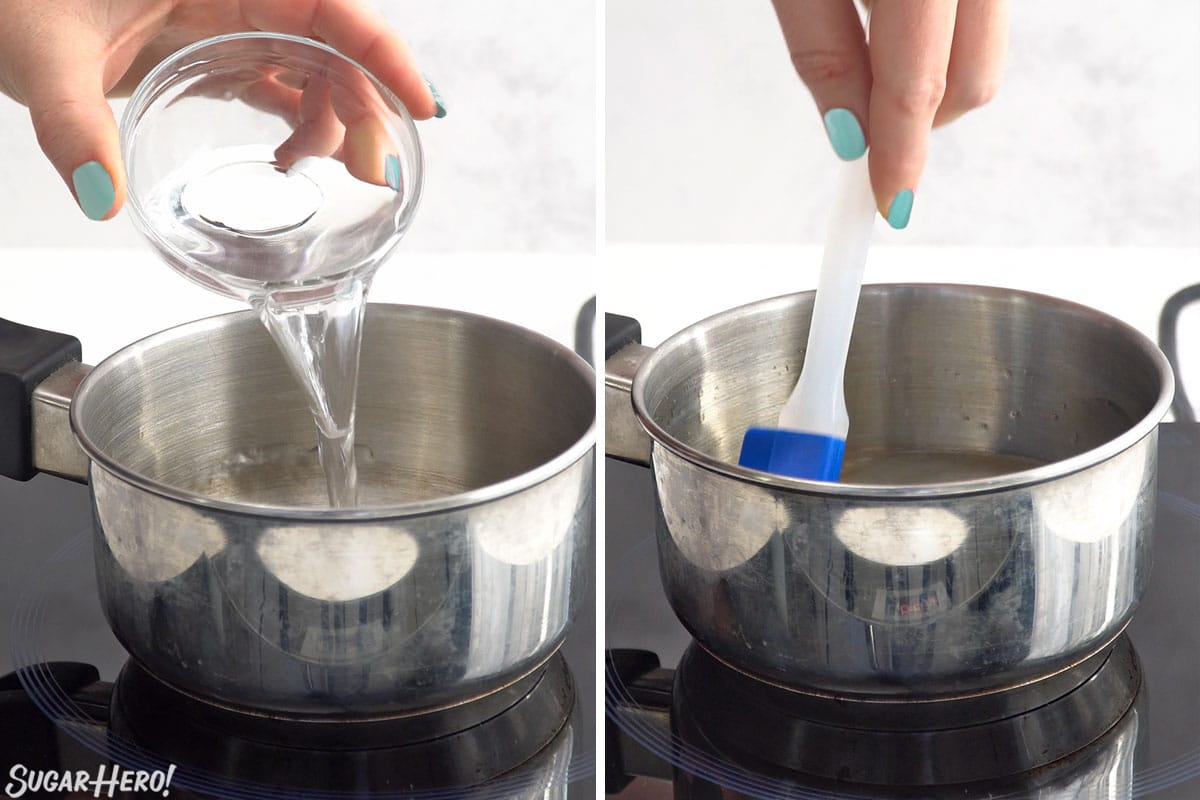
Make the sugar syrup
- Combine water, light corn syrup, and granulated sugar in a medium saucepan over medium-high heat.
- Stir until the sugar is moistened and dissolves.
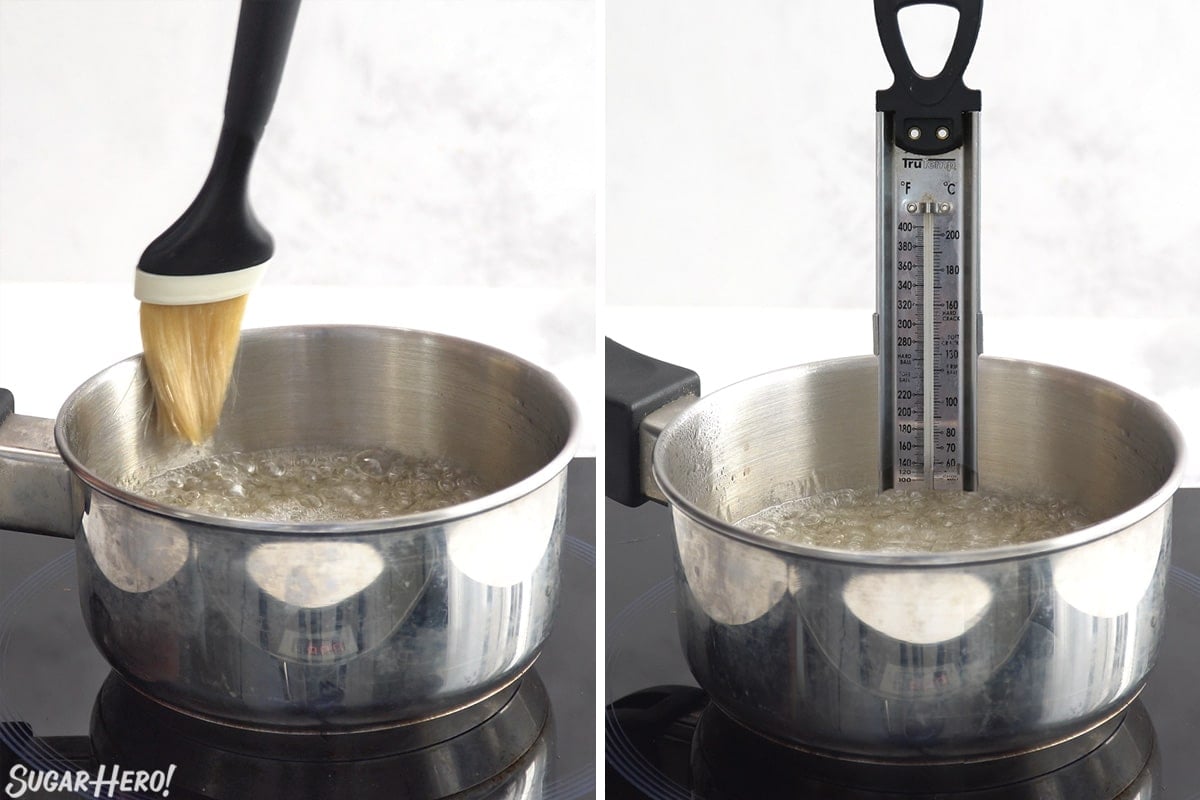
- Brush down the sides of the pan with a wet pastry brush – this will remove any stray sugar crystals. Sugar crystals in the pan can cause your whole batch to crystallize.
- Once it comes to a boil, insert a candy thermometer. From this point on, do not stir the candy.
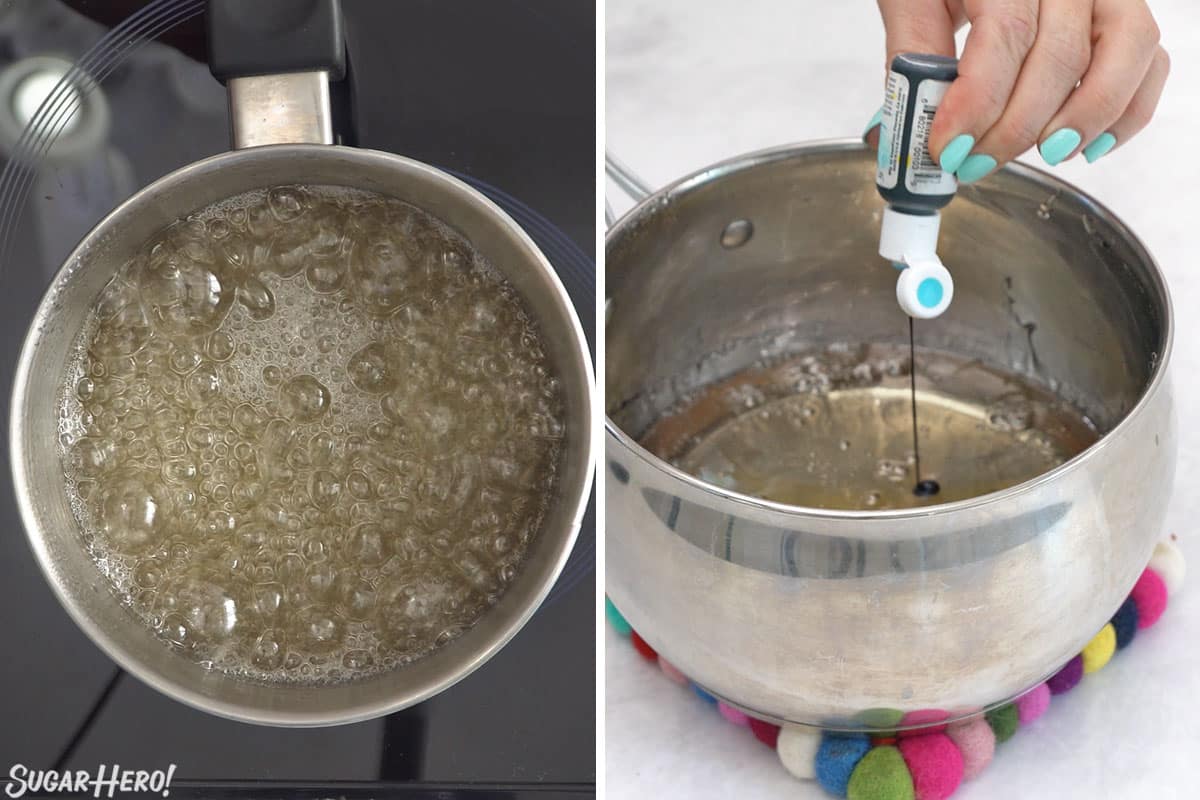
Cook and add coloring
- Cook the candy until it reaches 290 F on the thermometer. It should be a light yellowish color.
- Immediately remove the pan from the heat. Let it sit for a minute, until the rapid bubbling stops, then add flavoring extract and blue gel food coloring.
- Stir well until the color is evenly distributed.
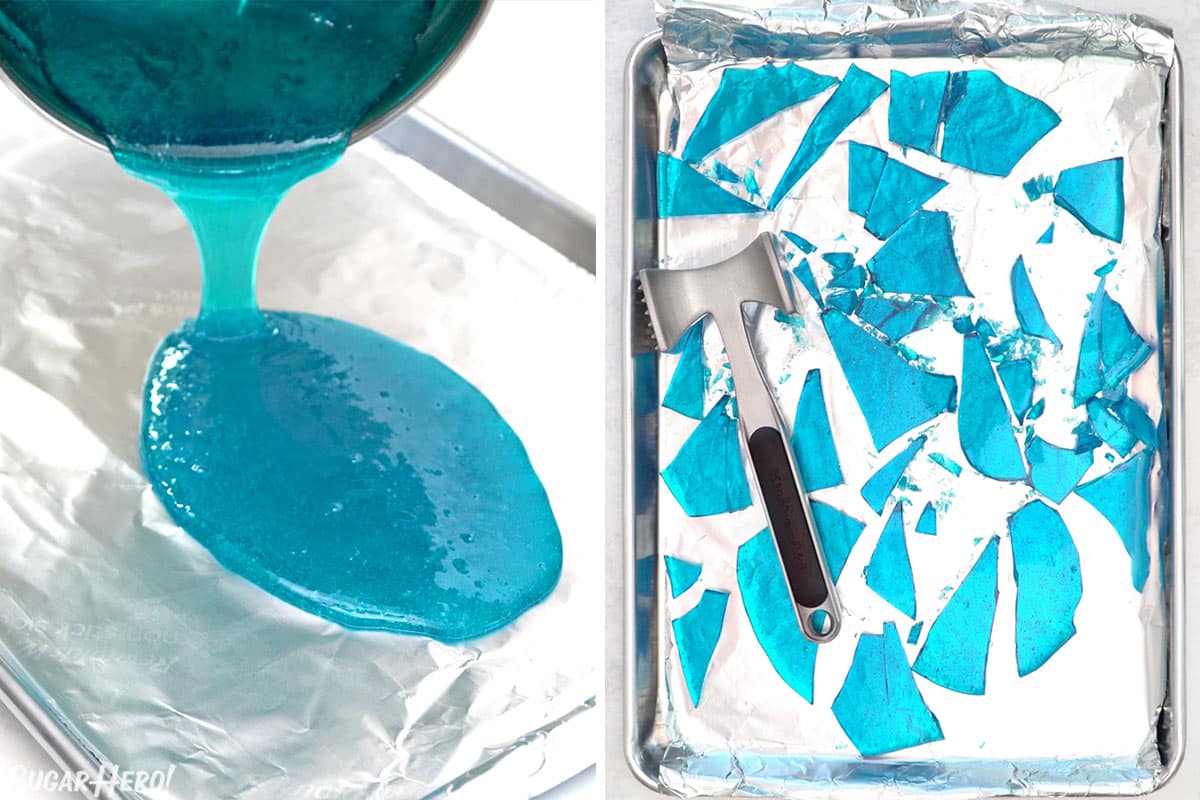
Pour and cool
- Pour the hot candy out onto a baking sheet covered with foil. You can spread it into a thinner layer with the spatula if you’d like.
- Let the candy cool completely at room temperature, until it is set and hard.
- Use a knife or kitchen mallet to smash it up into smaller pieces.
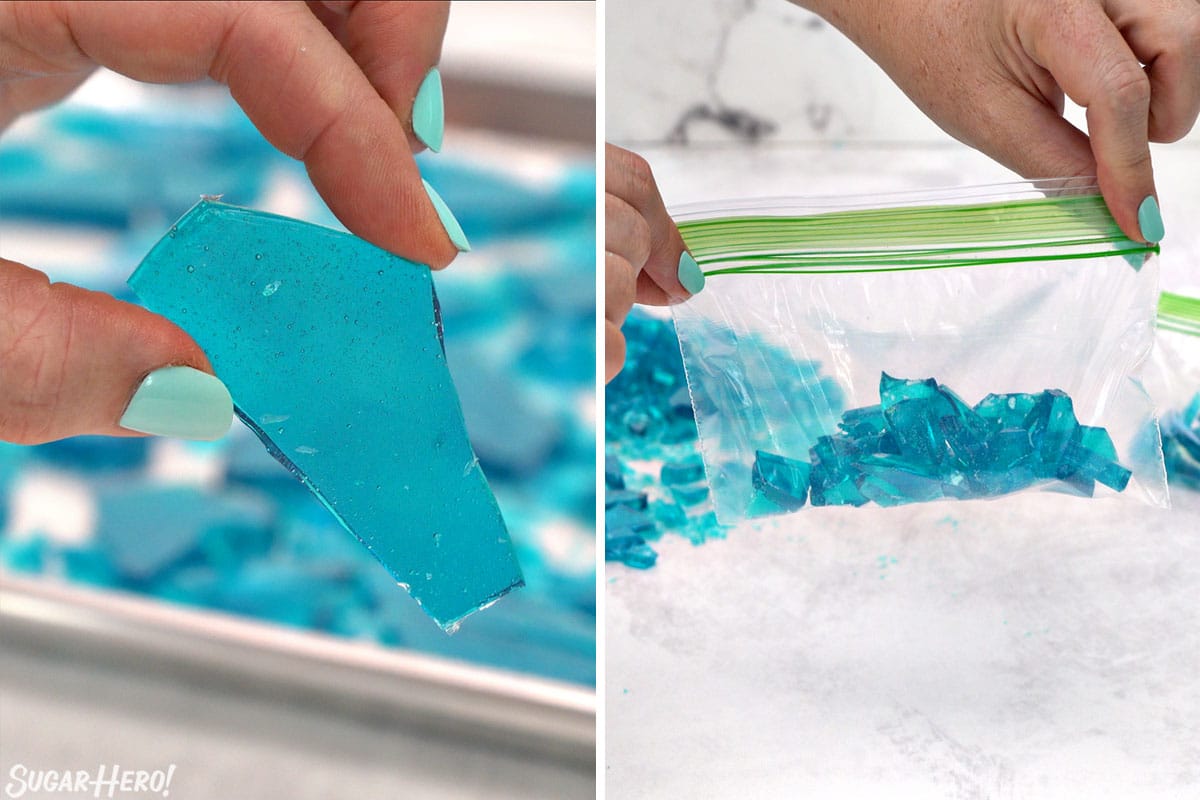
- This candy is easiest to eat in large pieces, so some people prefer to leave it in big chunks. If you want to be more accurate to the show, you can crush it up into smaller chunks.
- For optimal awesomeness, I recommend serving this in small baggies at a Breaking Bad viewing party.
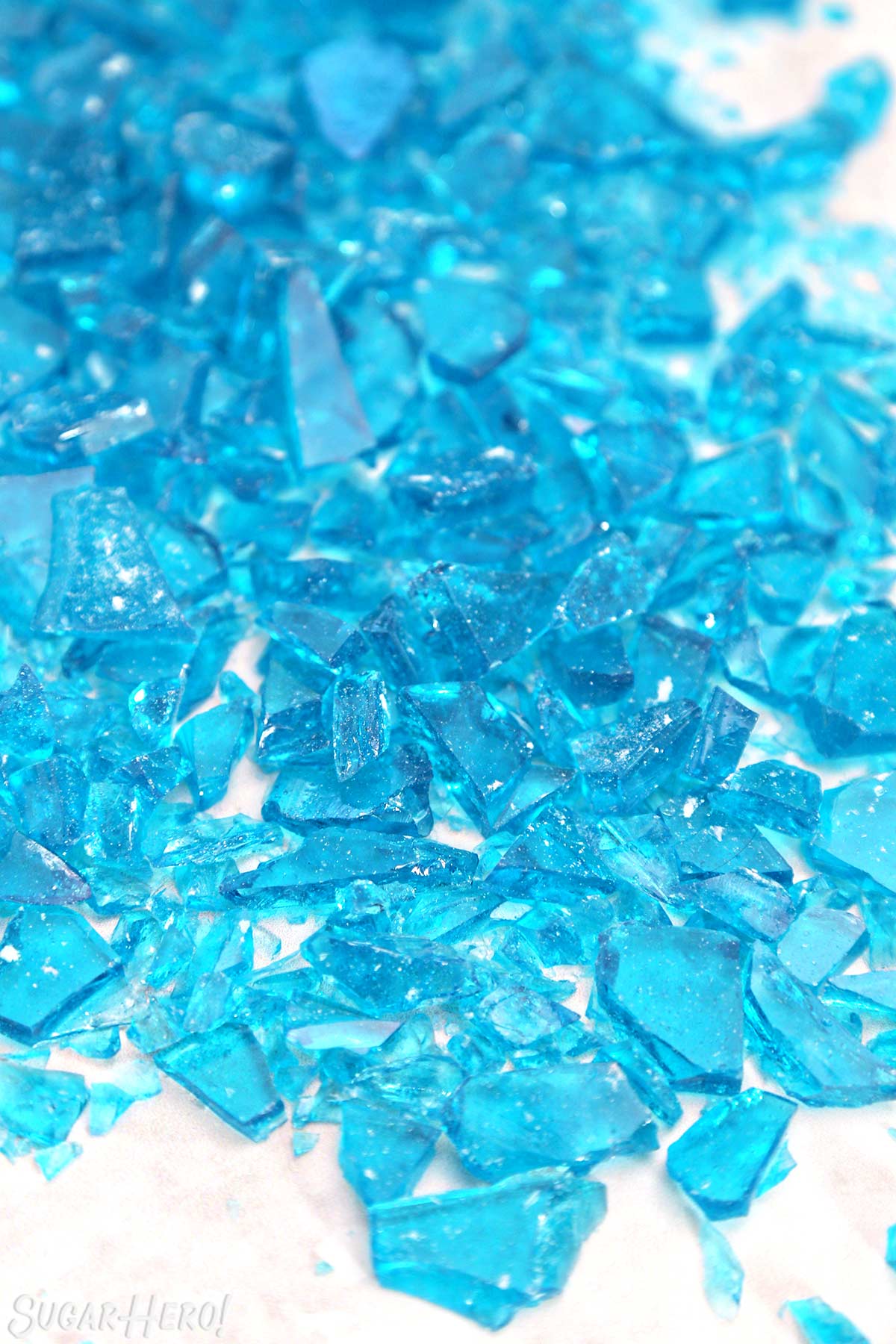
😋 Flavoring Recommendations
Clear flavoring is a must if you want your candy to stay clear and blue. You can always use clear vanilla, which is often available at cake and candy supply stores, and some larger grocery stores. It is imitation vanilla, so the flavor isn’t as great as real vanilla extract, but if you want vanilla candy, it’s your best bet.
My personal favorite is fruit flavors, since it seems like such a natural choice for hard candy. Here’s a partial list of clear candy flavorings. I like LorAnn because I think the quality, consistency, and flavors are great, but you can of course use any clear flavoring or extract brand that you like. Many of the larger LorAnn bottles are tinted so you can’t tell the color inside, but most of the 1-dram bottles are clear, so you can either view them online to check the color, or order them as an experiment before committing to a larger bottle.
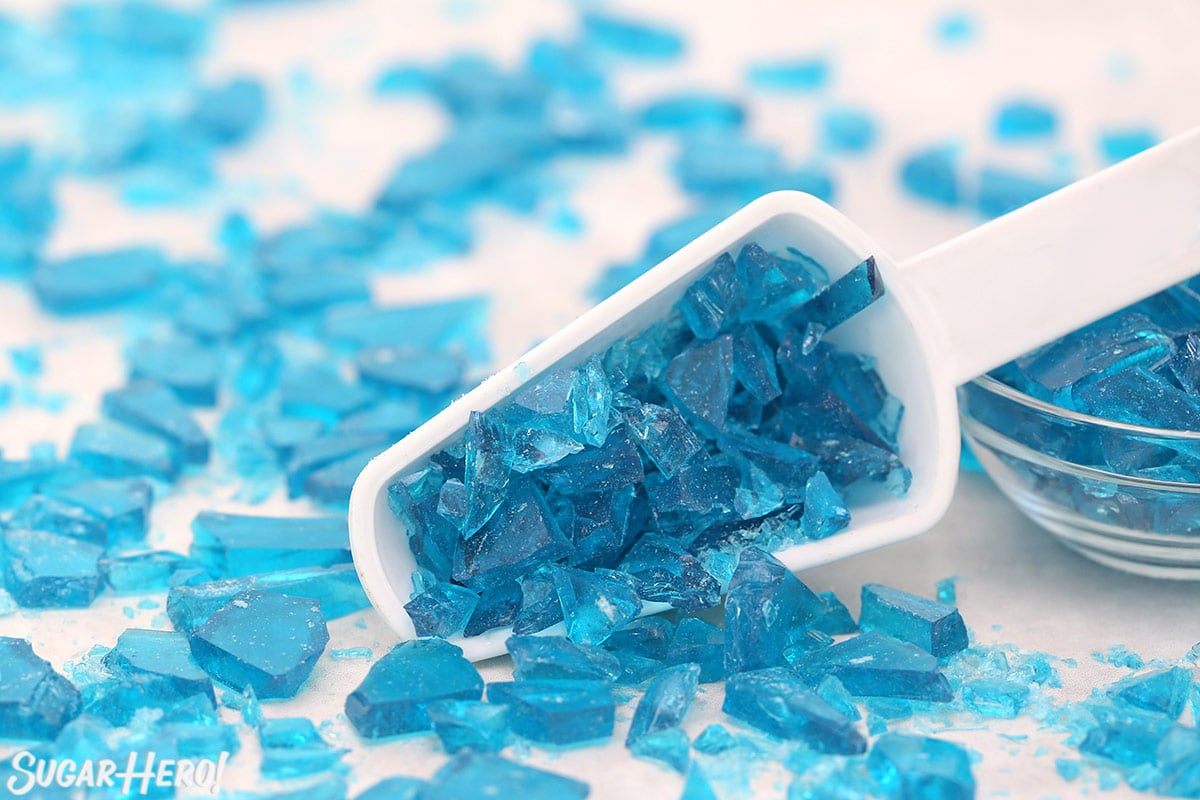
💡 Tips
Safely working with hot sugar
Hot sugar can be extremely dangerous — the temperature gets very high (290° F in this recipe!) and because it is a thick and sticky substance, if you accidentally get some on your skin, it doesn’t rinse off quickly, which can lead to serious burns.
Because of this, this is not a good recipe to make with smaller children. It’s also a good idea to have a bowl of ice water handy while the sugar syrup is cooking, so if you’re accidentally burned, you can immediately dunk your hand and stop further burning. And as always, be alert, deliberate, and careful with your movements in the kitchen.
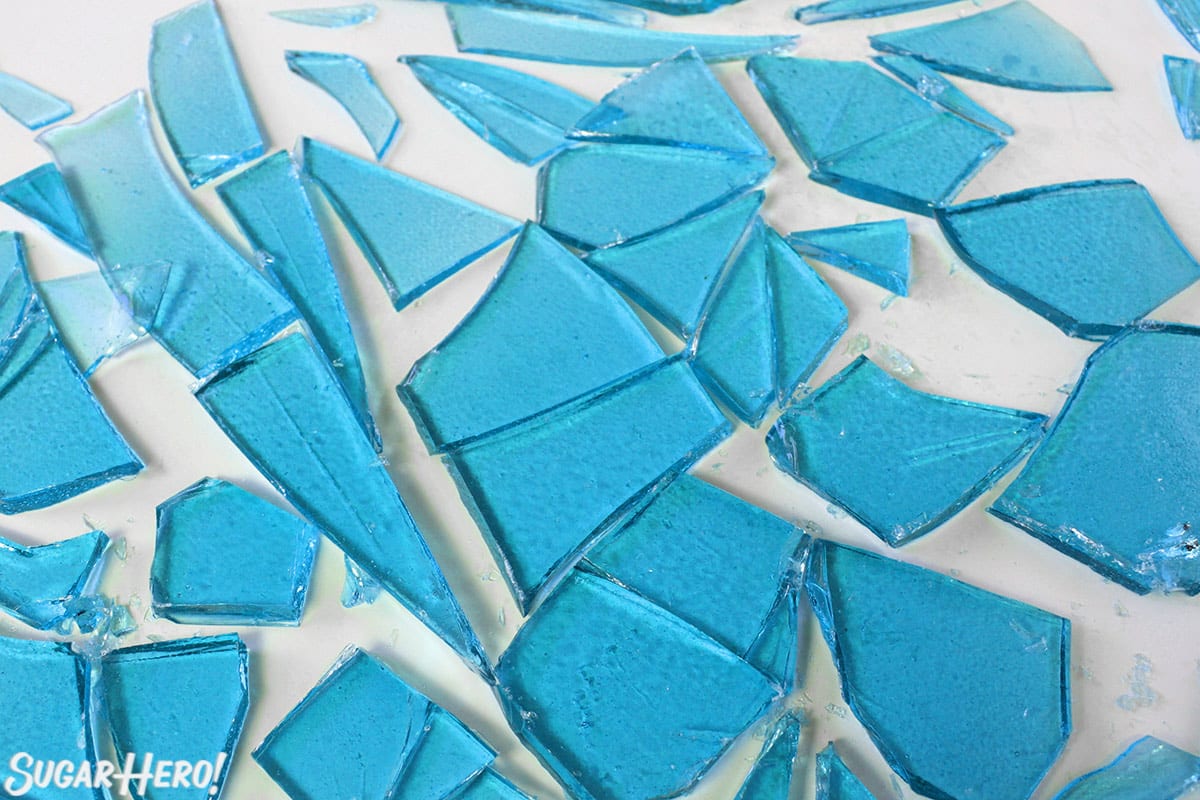
Testing your candy thermometer
It’s important to regularly test your candy thermometer for accuracy. Testing is especially important if you live at a higher altitude, but even at sea level, thermometers can become inaccurate over time. Having an accurate thermometer is essential to successful candy-making.
To test your thermometer, bring a pot of water to a boil, insert the candy thermometer for a minute, and then take a reading. At sea level, water boils at 212° F. If your thermometer doesn’t show 212°, calculate what the difference is. For example, if your thermometer reads 208° in boiling water, you know that you have a difference of -4 degrees in your thermometer. Going forward, you should subtract 4 degrees from any temperature written so that yours is accurate. In this example, if something needs to be cooked to 300° F, you only need to cook it to 296° F on your thermometer to get the right result.
The secret to easy candy removal
This isn’t a necessity like a candy thermometer, but it is a tip that can make your life a little easier! When making hard candy, I like to cover my baking sheets with non-stick foil. Hard candy can be sticky and difficult to remove from regular foil, but non-stick foil is magic, and the candy peels right off!
Other alternatives are to use a silicone baking mat, or spray regular or heavy-duty foil with nonstick cooking spray before beginning.
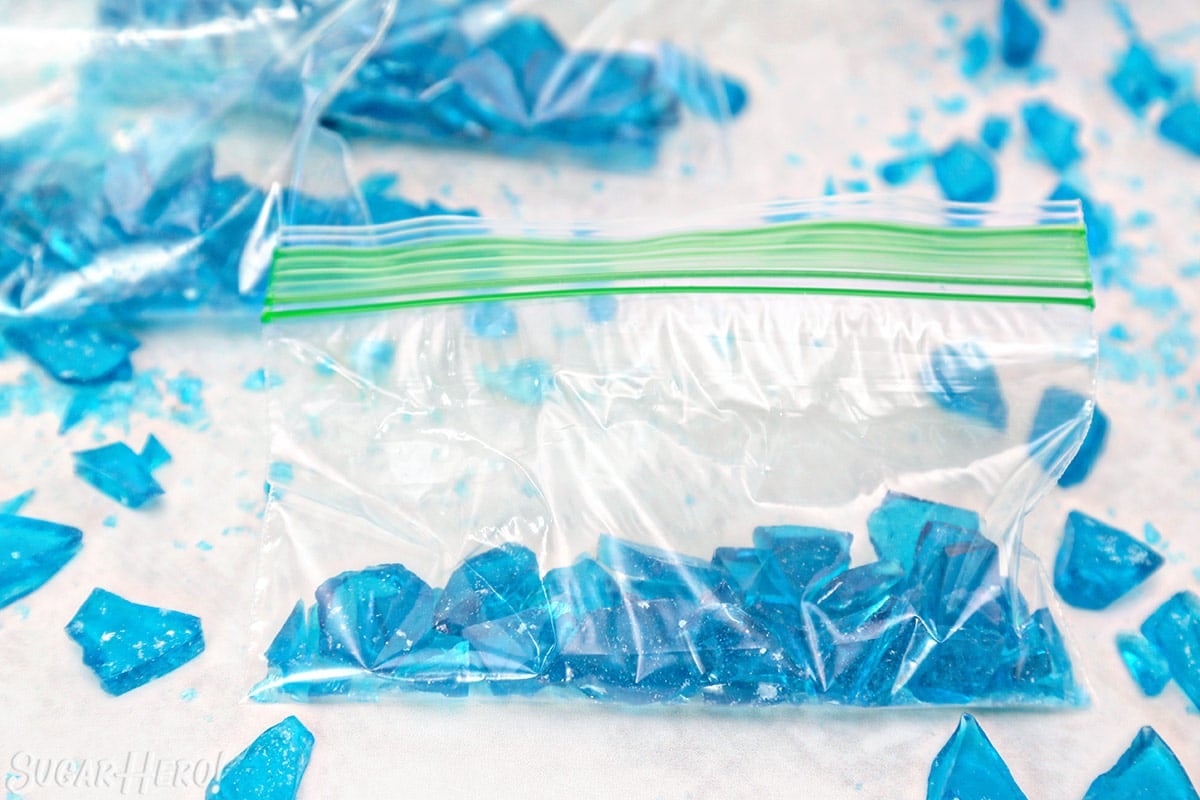
💡 Troubleshooting
Here are some common questions/difficulties people have had with this recipe, and my suggestions for how to prevent them.
This is the #1 problem people have with this recipe. There are 2 possible culprits: overcooking the candy, and using the wrong food coloring.
First, overcooking. The sugar syrup, if allowed to cook to a high temperature, will eventually turn yellow, then amber, then brown. This recipe calls for syrup to be cooked to 290 F, which should produce a near-colorless mixture that will not interfere with food coloring. (It will have a slight yellowish tinge.) If your candy is already a yellow or brown color when you’re adding the food coloring, chances are you have overcooked it, and the yellow color of the candy will mix with the blue dye and turn your candy green. The solution is to check to make sure your thermometer is accurate (see the Tips above) and to watch the candy like a hawk when it’s cooking.
Secondly, using the wrong food coloring. I have made this several times with Americolor Sky Blue, and have always had the color turn out well. I can’t guarantee other colors or brands will turn out the same. Liquid coloring, especially, can be weaker and can produce a greenish shade.
Here are a few colorings other readers have recommended: one reader says that the neon blue McCormick’s liquid food coloring produced a great blue color. She also recommends using a packet of Duncan Hines Frosting Creations in Cotton Candy, stirring it in at the very end and omitting any other flavoring and coloring. Another reader had great success with Adeco brand Electric Blue, and recommends using 5 drops for a great blue color.
If the candy is too soft or doesn’t set, it has not been cooked enough. This recipe really, truly should be measured using a candy thermometer, and if you are using one and still having problems with soft candy, test the accuracy of your thermometer, and double-check that you used the correct quantities and temperature the recipe calls for.
If the candy is initially fine but quickly becomes sticky, humidity is probably the problem. Hard candy works best in a dry environment–sugar soaks up moisture from the air around it, and hard candy quickly becomes wet and sticky in the humidity. Don’t attempt this candy on a humid or stormy day. It should always be stored in an airtight container at room temperature, to keep it as dry as possible. You can also buy silica gel packets to store with your candy to absorb moisture and keep it from becoming sticky.
If your candy is crumbly or sandy instead of hard and crunchy, or opaque instead of translucent, then it has crystallized during the cooking process. Nothing is wrong with it, and it will still taste fine, but the appearance and texture may not be what you want.
Crystallization happens when sugar crystals form during the cooking process. This can happen due to stirring too much while it cooks (once it comes to a boil, you should not be stirring it at all), or not wiping down the sides of the pan with a wet brush to remove the crystals, or just accidentally having stray crystals on the candy thermometer, spatula, or pan. The corn syrup in the recipe helps prevent crystals from forming, so if you substitute other ingredients for the corn syrup, you might find that crystallization is more likely.
This candy won’t spoil, but the texture will become softer and stickier over time. For the best results, store your candy in an airtight container at room temperature for several weeks. If you live in a humid climate, consider picking up some food-safe silica gel packets to store with the candy, to absorb moisture from the air and keep your candy fresh.

🍬 More Candies You’ll Love
Now that you’re a candy-making expert, put those skills to good use and try one of our other popular candy recipes!
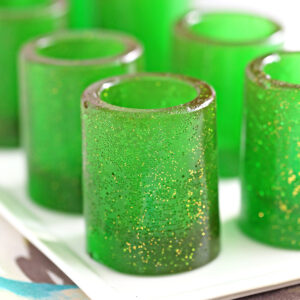
DIY Candy Shot Glasses
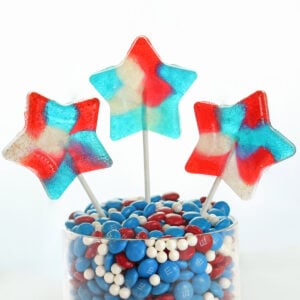
Easy Homemade Lollipops
Leave a Review!
If you make this recipe, let us know! Leave a ⭐️⭐️⭐️⭐️⭐️ rating on the recipe below, and leave a comment, take a photo and tag me on Instagram @elabau, or use #sugarhero on IG!
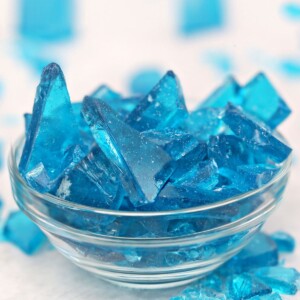
Breaking Bad Blue Rock Candy
Ingredients
- 1/2 cup water, (4 fl oz)
- 8.25 oz light corn syrup, (3/4 cup)
- 14 oz granulated sugar, (2 cups)
- 2 tsp clear flavoring extract
- blue gel food coloring, I used Americolor brand
- Candy thermometer
Instructions
- Line a baking sheet with foil and spray the foil with nonstick cooking spray, or use non-stick foil.
- In a medium saucepan, combine the water, corn syrup, and granulated sugar. Place the pan over medium-high heat, and stir until the sugar dissolves.
- Once it comes to a simmer, brush down the sides with a wet pastry brush to prevent sugar crystals from forming. Insert a candy thermometer.
- Continue to cook the candy without stirring until it reads 290 degrees Fahrenheit (143 C) on the thermometer. Watch the temperature carefully–a lower temperature might produce sticky candy, while a higher temperature runs the risk of producing green candy!
- Once at 290, take the pan off the heat and let it sit for a few moments, until rapid bubbles stop breaking on the surface. Add the flavoring and a drop or two of food coloring, and stir everything together.
- Pour the candy onto the prepared baking sheet and spread it into a thin layer. Let it set completely at room temperature.
- Once set, break it into small pieces. For the complete Breaking Bad experience, place the pieces in a large zip-top bag and smash them with a rolling pin until they are crushed, and place in small baggies to serve.
- Store the candy in an airtight container at room temperature.
Video
Measuring Tips
Our recipes are developed using weight measurements, and we highly recommend using a kitchen scale for baking whenever possible. However, if you prefer to use cups, volume measurements are provided as well. PLEASE NOTE: the adage “8 oz = 1 cup” is NOT true when speaking about weight, so don’t be concerned if the measurements don’t fit this formula.
Want to learn more about baking measurements and conversion?
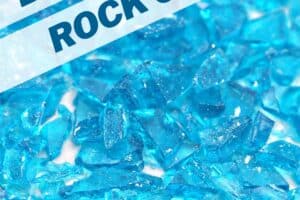
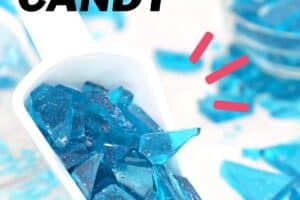
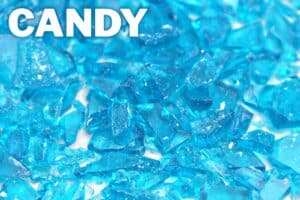
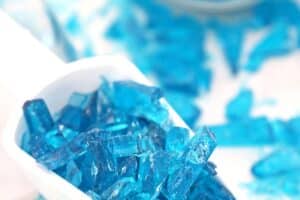
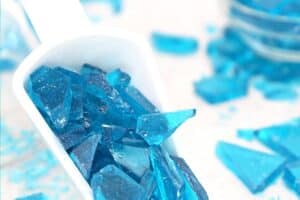
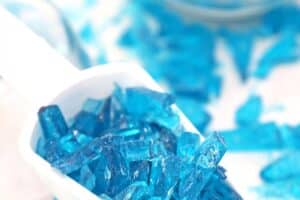

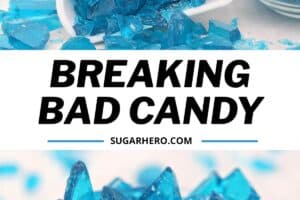
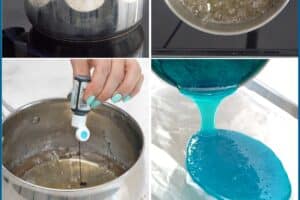
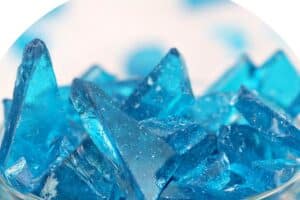
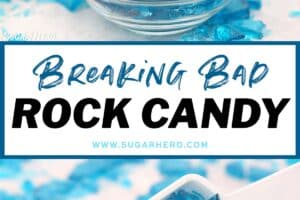
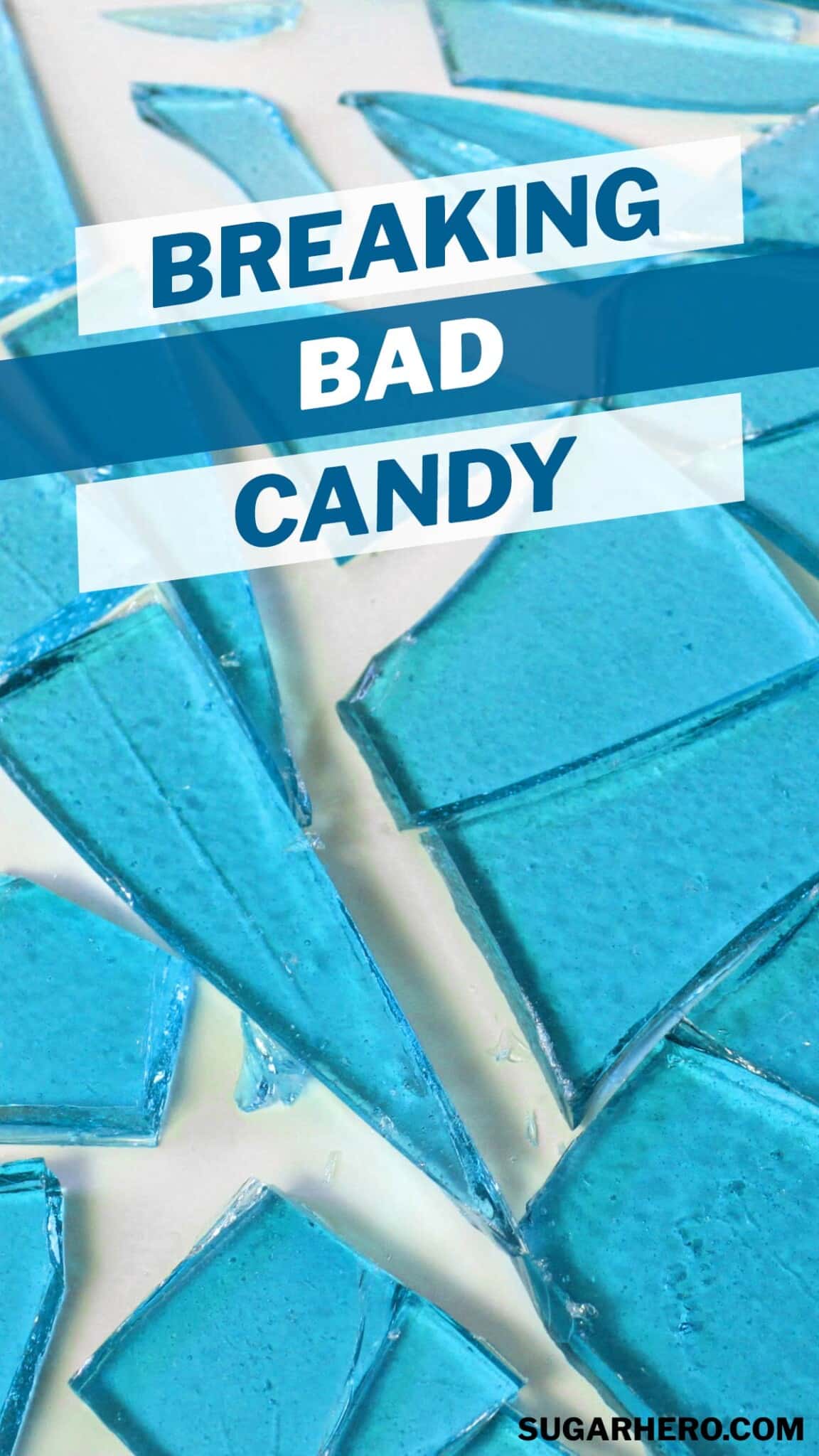
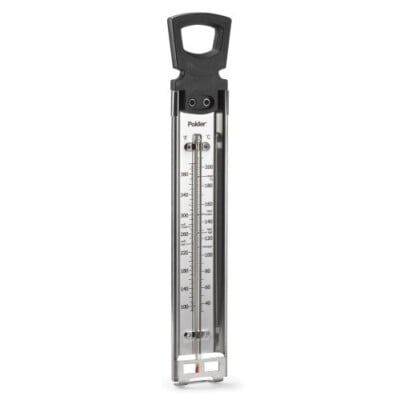
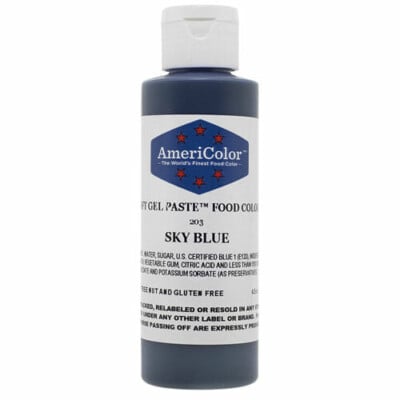
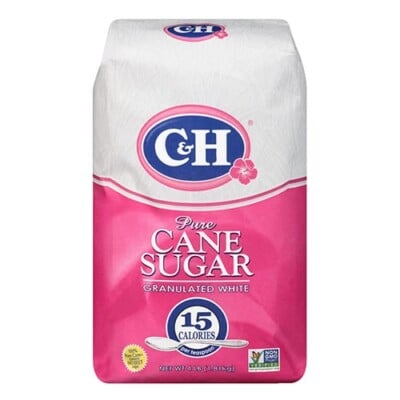
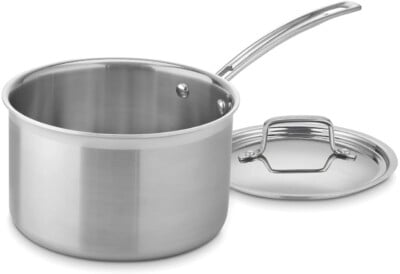
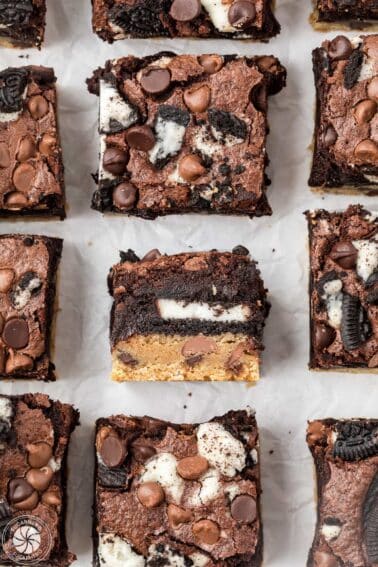
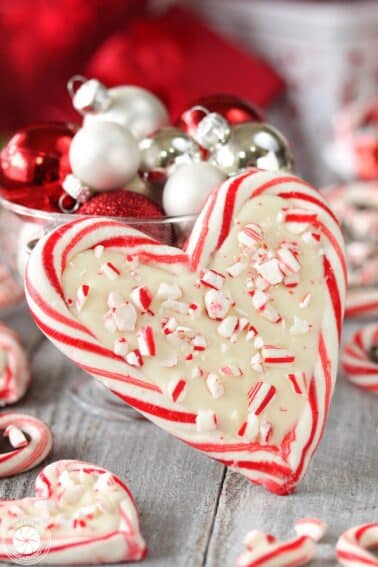
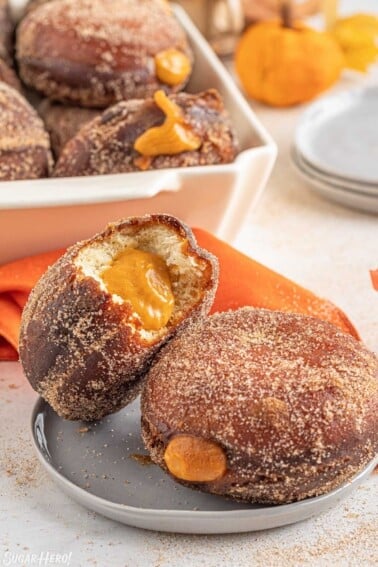
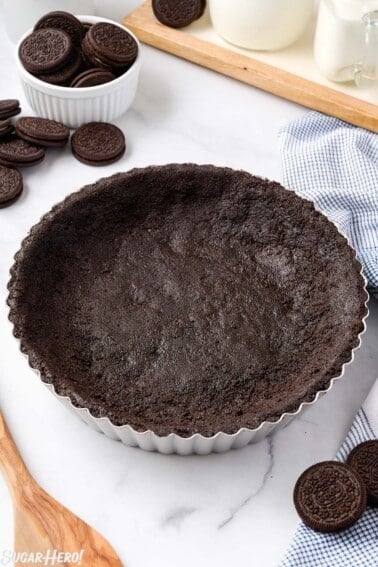












awesome! i’m obsessed w the show and made a menu of what to eat for the premiere:
http://theactorsdiet.com/2012/07/07/breaking-bad-premiere-menu/
That menu is awesome! I added a link in the post to your page ’cause I think it’s so fun.
thanks dear – i linked back to your recipe too and will share it on my Facebook too!!!
Respected Elizabeth…….em confuse when i read a word of (recipe)…..you are talking about the recipe of drugs?
Am I the only one on the Internet that is kind of shocked by this blatant glorification of a very real and very dangerous drug? SMH
Nope! You can see some comments above by people who share your perspective. In my opinion, this is a novelty item for adult fans of a certain television show. Obviously I would never market or sell it to children, but I personally don’t find anything wrong with making a batch and serving it to friends at a Breaking Bad party. Others may disagree, and I welcome (polite) discussion about it.
I’d like to pass on a comment with regard to the time factor involved with reaching the correct temperature (285F)before removing it from the heat. This was my first batch and the temp. reached 250 on my 3 different thermometers which I tested beforehand! I got worried. I increased the flame a bit (I had been conservative on the Med./High setting since I didn’t want to ruin it. But at Med. setting on the stove, it wouldn’t raise the temp. Finally I got brave and raised the flame to Med./High and with “patience” and the belief that it was going to work, it finally started to climb to the 285 goal! But the key word here is PATIENCE. I would like to advise you that after it starts to boil, it took us about 15 min. to reach the desired temp. So if you’re cautious like us and have to raise the flame gradually, don’t expect it to shoot up to the 285 in a flash. It WILL get there.
Also to those who oppose this type of “fun” – *get a life*! If you were a fan of the show, you should be tolerant enough to understand that art sometimes requires an open mind and elevating it to the level of humor is a sign of advanced intellect. Broaden your scope.
totally agree… when you personally have been affected by this, there is no humour. I am shocked too
What can I use instead of corn syrup? They use it here in fake maple syrup and it makes me sick.
Hi Glenn, Glucose is the best store-bought substitute for corn syrup, so if you can find glucose you can substitute that. Golden syrup would probably also work well, although I haven’t tried it with golden syrup so I can’t say for sure. You can also make your own corn syrup substitute out of granulated sugar! It adds an extra step to this recipe, but it’s probably worth it if you have a regular need for corn syrup, since it will keep for several months. Here’s one recipe: http://www.thekitchn.com/pantry-staples-diy-cane-sugar-131934
Great recipe! Quick question – What is flavoring extract and where do I get it?
Thanks!
Hi Carly! By “flavoring extract” I just meant any flavor you might use in baking or candy making: vanilla extract, mint extract, coconut, etc. If you don’t have some already, a good variety can usually be found in the baking aisle of a supermarket near the spices. I like to make hard candy with fruity flavors (berry, lemon, etc) but any extract should work.
If you find flavoring OILS used for candy, those are a lot more concentrated so only use about a quarter of the recommended amount if you’re using an oil instead of an extract.
I was just wondering how long does it usually take to harden after pouring the candy on the baking sheet? I want to make this before the premiere, time is counting down, and was hoping I could have some in time! Thanks for this recipe, a truly awesome idea!
Hi Luke! I would estimate about 30 minutes to cool down. Cooking the candy on my electric stove takes about 15 minutes, then 30-40 minutes to harden, and a little more time after that to bash it up into pieces–I’d put the recipe start to finish at about an hour, give or take depending on your stove and the temperature of your kitchen. Good luck, and let me know how it turns out!
if the candy didn’t harden, what would the likely reason be? i ended up with a gooey gel like pan of blue magic.
(the only thing i didnt do strictly to the instructions: i dont have a thermometer. so my best guess is too hot, or not hot enough.)
Hi Matt,
You’re right–the culprit is not cooking the candy enough. Basically you need to cook it to a high enough temperature so that enough water evaporates to leave the candy hard and brittle. If it’s not cooked long enough, it retains too much liquid and never sets.
A candy thermometer is the easiest fix for this problem (many grocery stores sell them in the baking aisle for around $5) but if you ever wanted to try it again without a thermometer, you can do the “cold water test.” As you’re cooking the candy, periodically drop a spoonful of the candy into a bowl of ice water. Let it sit a few seconds, then feel it with your hands. As it cooks it will progress from being a jelly-like substance, to a soft ball, then to a hard ball. Finally, when it crackles and turns into hard shards immediately upon being poured into the water, that’s when it’s ready.
This method works, but it’s a little more complicated, which is why I always recommend a thermometer instead. 🙂
nailed it the second time around.. thanks for the cold water test tip.
First time I’ve ever made candy.. Mine cracked but turns chewy in the mouth. Thinking this post will help me with this. This is definitely a nice touch to my Halloween costume.
Reminds me of being in school and making blue crystals with copper sulfate. I took some home in my pocket, year seven and accidently put in a bare unwrapped chocolate bar in the same pocket before eating with some blue crystals in the same mouthfull. I had worried about what it did to my body and brain since
Mine turned out green! Why? I used one drop, like you said. I used regular food coloring, as I had no “gel” coloring. Think that’s why?
Hi Mike,
I think the problem is the food coloring. Regular liquid food coloring isn’t as strong as gel coloring. When the candy is cooked to a high temperature it starts to take on a light amber color. This yellowish color, when combined with just a drop of (weaker) blue food coloring, could make the candy green instead of blue. If you were to make it again, I’d either use more liquid coloring, or switch to gel coloring.
Is there a specific shade of blue gel you use? I picked up royal blue and one drop turned it green so I put in a couple more and it ended up too dark.
Hi Nic,
I used one drop of Americolor Sky Blue gel food coloring, the kind you squeeze out from the bottle. I honestly would have thought royal blue would have worked as well. So sorry that the color didn’t turn out–hopefully the candy still tasted okay!
Ah yes, I have the same brand and there was Sky Blue coloring there as well but i went with the Royal. I will pick up the other color tomorrow and give it another go because my whole family loves the candy anyway! Great recipe!
How fitting! Sky blue is the name of Walt and Jesse’s meth. Thanks a lot for this recipe!
I hadn’t even realized! Obviously it’s a sign. 🙂 Thanks Matt!
My son is a huge BBad fan and he came across this recipe and has made it a few times now and it’s great!
Couple things: The NEON blue McCormick liquid food coloring is the exact right shade, if you can get that – we used that & lemon flavoring for the first batch. The second time we tried Tropical Punch KoolAid in lieu of the color/flavor but! note: just cuz the KoolAid pack is blue doesnt mean the powder is (it made a purpley red candy) And this last batch, made for the final we used a packet of Duncan Hines Frosting Creations in the Cotton Candy flavor instead of the coloring/flavoring ingredients – it’s the PERFECT color, and has a very nice candy taste – the best batch yet we thought!
Just some tips we thought we’d share for anyone else wanting to give the recipe a try. Thanks Elizabeth, for posting the recipe – I guess it’s kinda weird to let my teenager cook candy “meth” – but I was just happy he was motivated to get in the kitchen and make a recipe, period! 🙂
Hi Gem,
Thanks for all the tips! It’s great to know about the food coloring–I think McCormick’s is probably easier to find than Americolor, so that’s useful for other people…and the Frosting Creations idea is genius!
I’m laughing at the thought of you encouraging your son to cook meth–at least you know what he’s up to, right? 🙂
When using the Duncan Hines frosting… is it for the same size batch as the posted recipe, and how much do you use? Thanks! 🙂
Samantha,
I haven’t tried it, but my guess would be that it was for the same sized batch. Don’t know about the quantity–you might try adding half the packet and if the color isn’t strong enough, adding the rest? Please post back if you try it!
Thanks for the recipe. I made the mistake of using unbleached sugar so it came out green-brown. Also, I think this amount might work well in a 10″ x 15″ pyrex dish since I doubled it and my product was too thick.